Sonochemical Synthesis of CuO Nanoplatelets and Their Tribological Properties as an Additive in Synthetic Oil Using Reciprocating Tribometer
Abstract
1. Introduction
2. Materials and Methods
2.1. Synthesis of CuO NPs
2.2. Design and Setup
2.3. Preparation of Nanolubricants
2.4. Testing Conditions
3. Results and Discussions
3.1. Structural Characterization
3.2. Morphological Characterization
3.3. Effect on Morphology after Mixing in Oil
3.4. Dispersion of Nanoparticles (NPs)
3.5. Zeta Potential of Nanolubricants
3.6. Tribological Characterization
4. Conclusions
- CuO nanoparticles were successfully synthesized using the sonochemical method and characterized using various techniques. The nanoparticles exhibited plate shapes which can be achieved using the sonochemical method.
- A reciprocating tribometer was designed and fabricated to measure the coefficient of friction (COF) of nanolubricants.
- Nanolubricants were prepared by varying the weight percent concentrations of CuO nanoparticles, and a 0.1% concentration of CuO nanoparticles as an additive in lubricating oil exhibited the lowest COF. The reduction in COF was 32% compared to pure synthetic oil.
- SEM and FE-TEM analyses confirmed the formation of a tribo-film over the CuO nanoparticles, which played a significant role in reducing the COF.
- Zeta potential measurements verified the good quality dispersion of 0.1% concentration of CuO nanoparticles as an additive in the lubricating oil.
- Wear track visual analysis using SEM demonstrated the best results for 0.1% concentration.
- The analysis of roughness parameters corroborates the findings obtained from tribometers and SEM analysis.
- The study suggests that a 0.1% concentration of CuO nanoparticles is the optimized value for using them as an additive in fully synthetic motor oil (SEA 5W-40).
- The findings of this study suggest the promising application of synthesized CuO nanoparticles as an additive in a commercially available fully synthetic lubricating oil (SEA 5W-40) to enhance its tribological properties.
- Advanced lubrication using CuO nanoparticles as additives has the potential to enhance the efficiency and lifespan of machines, and consequently reduce energy demand.
Author Contributions
Funding
Data Availability Statement
Conflicts of Interest
References
- Zhou, J.; Wu, Z.; Zhang, Z.; Liu, W.; Xue, Q. Tribological behavior and lubricating mechanism of Cu nanoparticles in oil. Tribol. Lett. 2000, 8, 213–218. [Google Scholar] [CrossRef]
- Kreivaitis, R.; Gumbytė, M.; Kupčinskas, A.; Kazancev, K.; Ta, T.N.; Horng, J.H. Investigation of tribological properties of two protic ionic liquids as additives in water for steel–steel and alumina–steel contacts. Wear 2020, 456–457, 203390. [Google Scholar] [CrossRef]
- Xiong, S.; Liang, D.; Kong, F. Effect of pH on the Tribological Behavior of Eu-Doped WO3 Nanoparticle in Water-Based Fluid. Tribol. Lett. 2020, 68, 126. [Google Scholar] [CrossRef]
- Du, Y.; Zhang, Z.; Wang, D.; Zhang, L.; Cui, J.; Chen, Y.; Wu, M.; Kang, R.; Lu, Y.; Yu, J.; et al. Enhanced tribological properties of aligned graphene-epoxy composites. Friction 2022, 10, 854–865. [Google Scholar] [CrossRef]
- Guegan, J.; Southby, M.; Spikes, H. Friction Modifier Additives, Synergies and Antagonisms. Tribol. Lett. 2019, 67, 83. [Google Scholar] [CrossRef]
- Shenoy, B.S.; Binu, K.G.; Pai, R.S.; Rao, D.S.; Pai, R.S. Effect of nanoparticles additives on the performance of an externally adjustable fluid film bearing. Tribol. Int. 2012, 45, 38–42. [Google Scholar] [CrossRef]
- Zhao, J.; Yang, G.; Zhang, Y.; Zhang, S.; Zhang, C.; Gao, C.; Zhang, P. Controllable synthesis of different morphologies of CuO nanostructures for tribological evaluation as water-based lubricant additives. Friction 2021, 9, 963–977. [Google Scholar] [CrossRef]
- Abdel-Rehim, A.A.; Akl, S.; Elsoudy, S. Investigation of the tribological behavior of mineral lubricant using copper oxide nano additives. Lubricants 2021, 9, 16. [Google Scholar] [CrossRef]
- Shafi, W.K.; Charoo, M.S. An overall review on the tribological, thermal and rheological properties of nanolubricants. Tribol.—Mater. Surf. Interfaces 2021, 15, 20–54. [Google Scholar] [CrossRef]
- Huang, S.; Wang, Z.; Xu, L.; Huang, C. Friction and Wear Characteristics of Aqueous ZrO2/GO Hybrid Nanolubricants. Lubricants 2022, 10, 109. [Google Scholar] [CrossRef]
- Dembelova, T.; Badmaev, B.; Makarova, D.; Mashanov, A.; Mishigdorzhiyn, U. Rheological and Tribological Study of Polyethylsiloxane with SiO2 Nanoparticles Additive. Lubricants 2022, 11, 9. [Google Scholar] [CrossRef]
- Trivedi, K. Analyzing lubrication properties of magnetic lubricant synthesized in two lubricating oils. Wear 2021, 477, 203861. [Google Scholar] [CrossRef]
- Alqahtani, B.; Hoziefa, W.; Moneam, H.M.A.; Hamoud, M.; Salunkhe, S.; Elshalakany, A.B.; Abdel-Mottaleb, M.; Davim, J.P. Tribological Performance and Rheological Properties of Engine Oil with Graphene Nano-Additives. Lubricants 2022, 10, 137. [Google Scholar] [CrossRef]
- Rylski, A.; Siczek, K. The Effect of Addition of Nanoparticles, Especially ZrO2-Based, on Tribological Behavior of Lubricants. Lubricants 2020, 8, 23. [Google Scholar] [CrossRef]
- Szabó, Á.I.; Tóth, Á.D.; Leskó, M.Z.; Hargitai, H. Investigation of the Applicability of Y2O3–ZrO2 Spherical Nanoparticles as Tribological Lubricant Additives. Lubricants 2022, 10, 152. [Google Scholar] [CrossRef]
- Padgurskas, J.; Rukuiza, R.; Prosyčevas, I.; Kreivaitis, R. Tribological properties of lubricant additives of Fe, Cu and Co nanoparticles. Tribol. Int. 2013, 60, 224–232. [Google Scholar] [CrossRef]
- Prabu, L.; Saravanakumar, N.; Rajaram, G. Influence of Ag Nanoparticles for the Anti-wear and Extreme Pressure Properties of the Mineral Oil Based Nano-cutting Fluid. Tribol. Ind. 2018, 40, 440–447. [Google Scholar] [CrossRef]
- Shahnazar, S.; Bagheri, S.; Abd Hamid, S.B. Enhancing lubricant properties by nanoparticle additives. Int. J. Hydrogen Energy 2016, 41, 3153–3170. [Google Scholar] [CrossRef]
- Laad, M.; Jatti, V.K.S. Titanium oxide nanoparticles as additives in engine oil. J. King Saud Univ.—Eng. Sci. 2018, 30, 116–122. [Google Scholar] [CrossRef]
- Dai, W.; Kheireddin, B.; Gao, H.; Liang, H. Roles of nanoparticles in oil lubrication. Tribol. Int. 2016, 102, 88–98. [Google Scholar] [CrossRef]
- Alves, S.M.; Mello, V.S.; Faria, E.A.; Camargo, A.P.P. Nanolubricants developed from tiny CuO nanoparticles. Tribol. Int. 2016, 100, 263–271. [Google Scholar] [CrossRef]
- Gulzar, M.; Masjuki, H.; Varman, M.; Kalam, M.; Mufti, R.A.; Zulkifli, N.; Yunus, R.; Zahid, R. Improving the AW/EP ability of chemically modified palm oil by adding CuO and MoS2 nanoparticles. Tribol. Int. 2015, 88, 271–279. [Google Scholar] [CrossRef]
- Peña-Parás, L.; Taha-Tijerina, J.; Garza, L.; Maldonado-Cortés, D.; Michalczewski, R.; Lapray, C. Effect of CuO and Al2O3 nanoparticle additives on the tribological behavior of fully formulated oils. Wear 2015, 332–333, 1256–1261. [Google Scholar] [CrossRef]
- Hernández Battez, A.; González, R.; Viesca, J.L.; Fernández, J.E.; Díaz Fernández, J.M.; Machado, A.; Chou, R.; Riba, J. CuO, ZrO2 and ZnO nanoparticles as antiwear additive in oil lubricants. Wear 2008, 265, 422–428. [Google Scholar] [CrossRef]
- Gupta, R.N.; Harsha, A.P. Tribological study of castor oil with surface-modified CuO nanoparticles in boundary lubrication. Ind. Lubr. Tribol. 2018, 70, 700–710. [Google Scholar] [CrossRef]
- Thottackkad, M.V.; Rajendrakumar, P.K.; Prabhakaran Nair, K. Experimental studies on the tribological behaviour of engine oil (SAE15W40) with the addition of CuO nanoparticles. Ind. Lubr. Tribol. 2014, 66, 289–297. [Google Scholar] [CrossRef]
- Bhaumik, S.; Pathak, S.D. Analysis of anti-wear properties of cuo nanoparticles as friction modifiers in mineral oil (460cst viscosity) using pin-on-disk tribometer. Tribol. Ind. 2015, 37, 196–203. [Google Scholar]
- Salguero, J.; Vazquez-Martinez, J.; Sol, I.; Batista, M. Application of Pin-On-Disc Techniques for the Study of Tribological Interferences in the Dry Machining of A92024-T3 (Al–Cu) Alloys. Materials 2018, 11, 1236. [Google Scholar] [CrossRef]
- Velkavrh, I.; Lüchinger, M.; Kern, K.; Klien, S.; Ausserer, F.; Voyer, J.; Diem, A.; Schreiner, M.; Tillmann, W. Using a standard pin-on-disc tribometer to analyse friction in a metal forming process. Tribol. Int. 2017, 114, 418–428. [Google Scholar] [CrossRef]
- Jackson, C.L.; Mosley, D.W. Model Friction Studies of Chemical Mechanical Planarization Using a Pin-on-Disk Tribometer. Tribol. Lett. 2019, 67, 81. [Google Scholar] [CrossRef]
- Hernández Battez, A.; González, R.; Felgueroso, D.; Fernández, J.E.; del Rocío Fernández, M.; García, M.A.; Peñuelas, I. Wear prevention behaviour of nanoparticle suspension under extreme pressure conditions. Wear 2007, 263, 1568–1574. [Google Scholar] [CrossRef]
- Chenga Reddy, P.; Arumugam, S.; Nithin Sai Krishna, P.; Jaya Sainath, N. Tribological investigation of a compressor liner-ring material under various bio-based lubricants using HFRR tribometer. IOP Conf. Ser. Mater. Sci. Eng. 2018, 390, 012025. [Google Scholar] [CrossRef]
- Balakumar, R.; Sriram, G.; Arumugam, S. Assessment on Tribological Characteristics of Waste Ayurvedic Oil Biodiesel Blends using High-Frequency Reciprocating Rig Tribometer. IOP Conf. Ser. Mater. Sci. Eng. 2018, 390, 012047. [Google Scholar] [CrossRef]
- Shahsavani, E.; Feizi1, N.; Khalaji, A.D. Copper oxide nanoparticles by solid-state thermal decomposition: Synthesis and characterization. J. Ultrafine Grained Nanostruct. Mater. 2016, 49, 48–50. [Google Scholar]
- Dagher, S.; Haik, Y.; Ayesh, A.I.; Tit, N. Synthesis and optical properties of colloidal CuO nanoparticles. J. Lumin. 2014, 151, 149–154. [Google Scholar] [CrossRef]
- Kumaresan, N.; Ramamurthi, K.; Mathuri, S.; Maria Angelin Sinthiya, M.; Manimozhi, T.; Margoni, M.M.; Rameshbabu, R. Solid state synthesis of Cuo nanoparticles for photo catalytic application. Int. J. ChemTech. Res. 2015, 7, 1598–1602. [Google Scholar]
- Kayani, Z.N.; Umer, M.; Riaz, S.; Naseem, S. Characterization of Copper Oxide Nanoparticles Fabricated by the Sol–Gel Method. J. Electron. Mater. 2015, 44, 3704–3709. [Google Scholar] [CrossRef]
- Azam, A. Size-dependent antimicrobial properties of CuO nanoparticles against Gram-positive and -negative bacterial strains. Int. J. Nanomed. 2012, 7, 3527. [Google Scholar] [CrossRef]
- Chen, Y.; Renner, P.; Liang, H. Dispersion of Nanoparticles in Lubricating Oil: A Critical Review. Lubricants 2019, 7, 7. [Google Scholar] [CrossRef]
- Kumar, A.; Dixit, C.K. Methods for characterization of nanoparticles. In Advances in Nanomedicine for the Delivery of Therapeutic Nucleic Acids; Elsevier: Amsterdam, The Netherlands, 2017; pp. 43–58. ISBN 9780081005576. [Google Scholar]
- Joly-Pottuz, L.; Vacher, B.; Ohmae, N.; Martin, J.M.; Epicier, T. Anti-wear and friction reducing mechanisms of carbon nano-onions as lubricant additives. Tribol. Lett. 2008, 30, 69–80. [Google Scholar] [CrossRef]
- Sahin, M.; Çetinarslan, C.S.; Akata, H.E. Effect of surface roughness on friction coefficients during upsetting processes for different materials. Mater. Des. 2007, 28, 633–640. [Google Scholar] [CrossRef]
- Tian, S.F.; Jiang, L.T.; Guo, Q.; Wu, G.H. Effect of surface roughness on tribological properties of TiB2/Al composites. Mater. Des. 2014, 53, 129–136. [Google Scholar] [CrossRef]
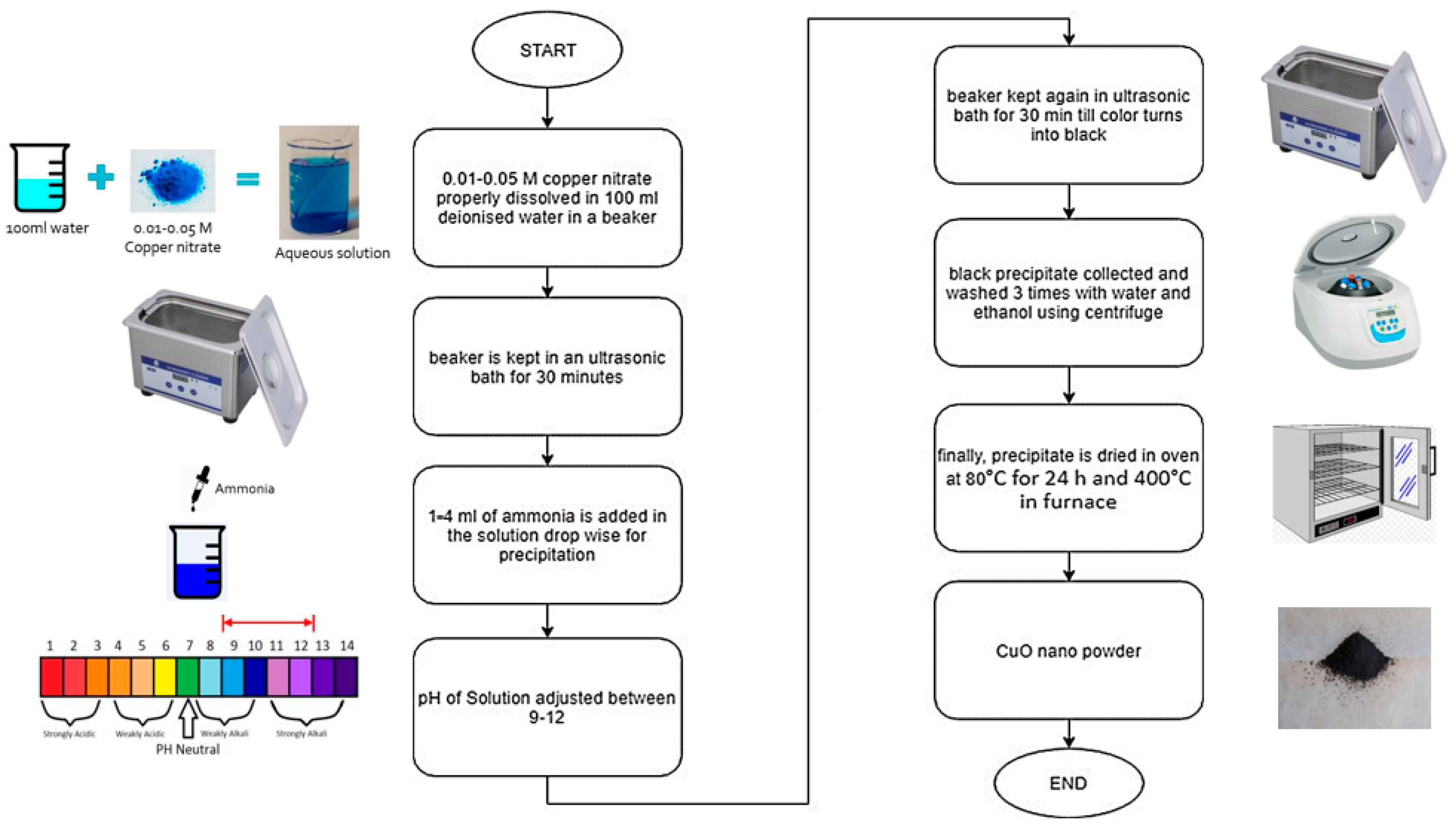

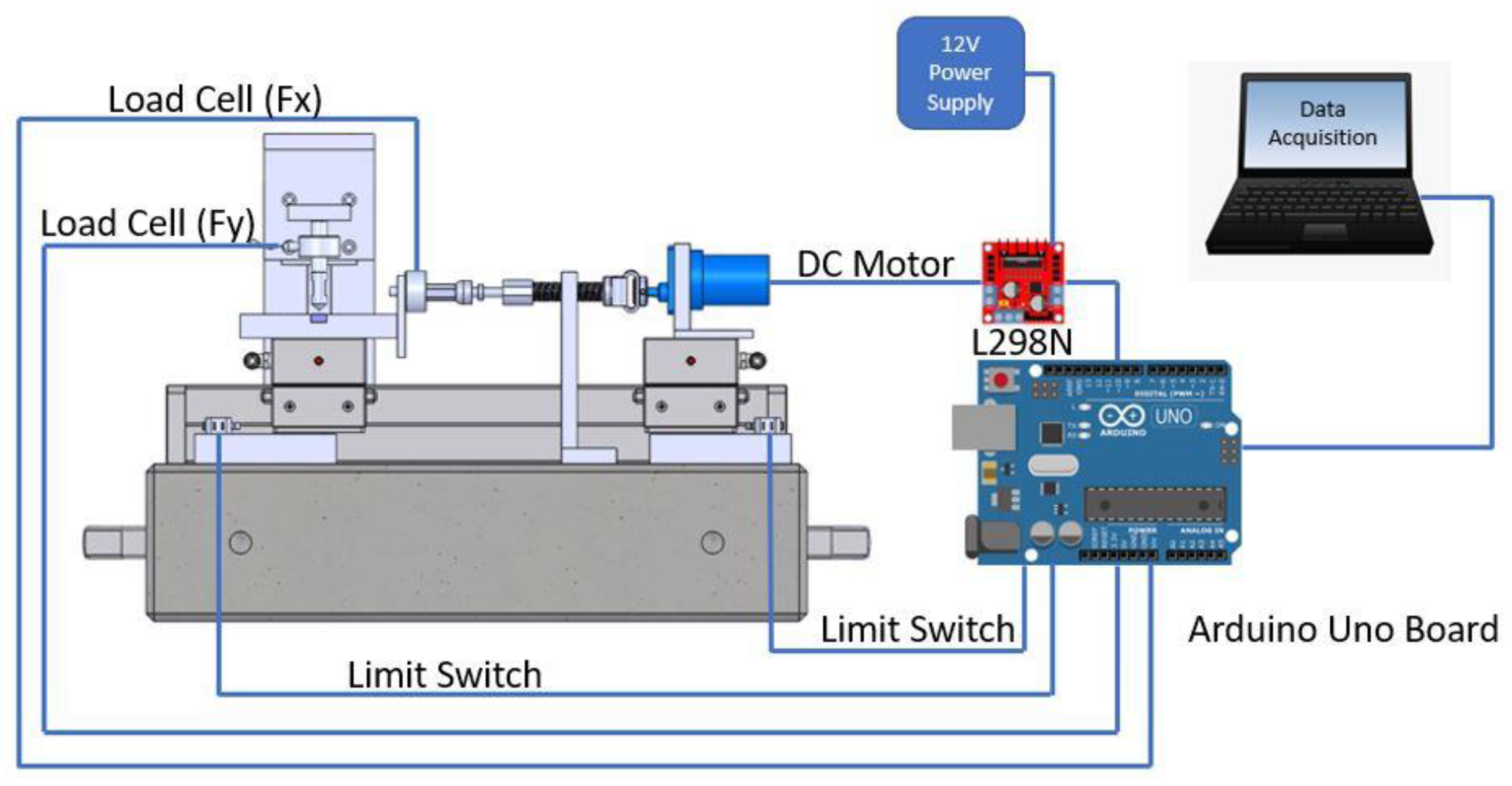
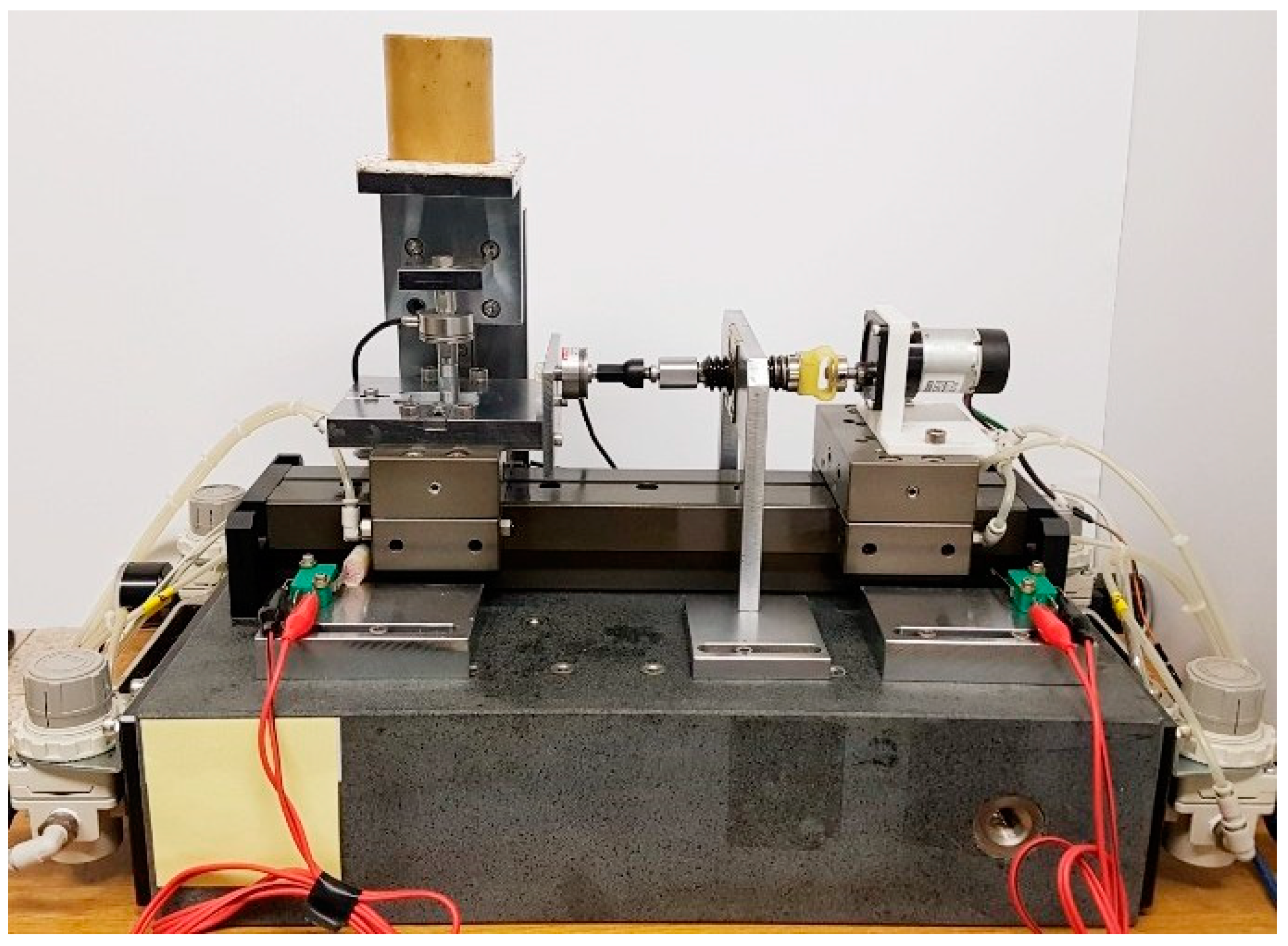
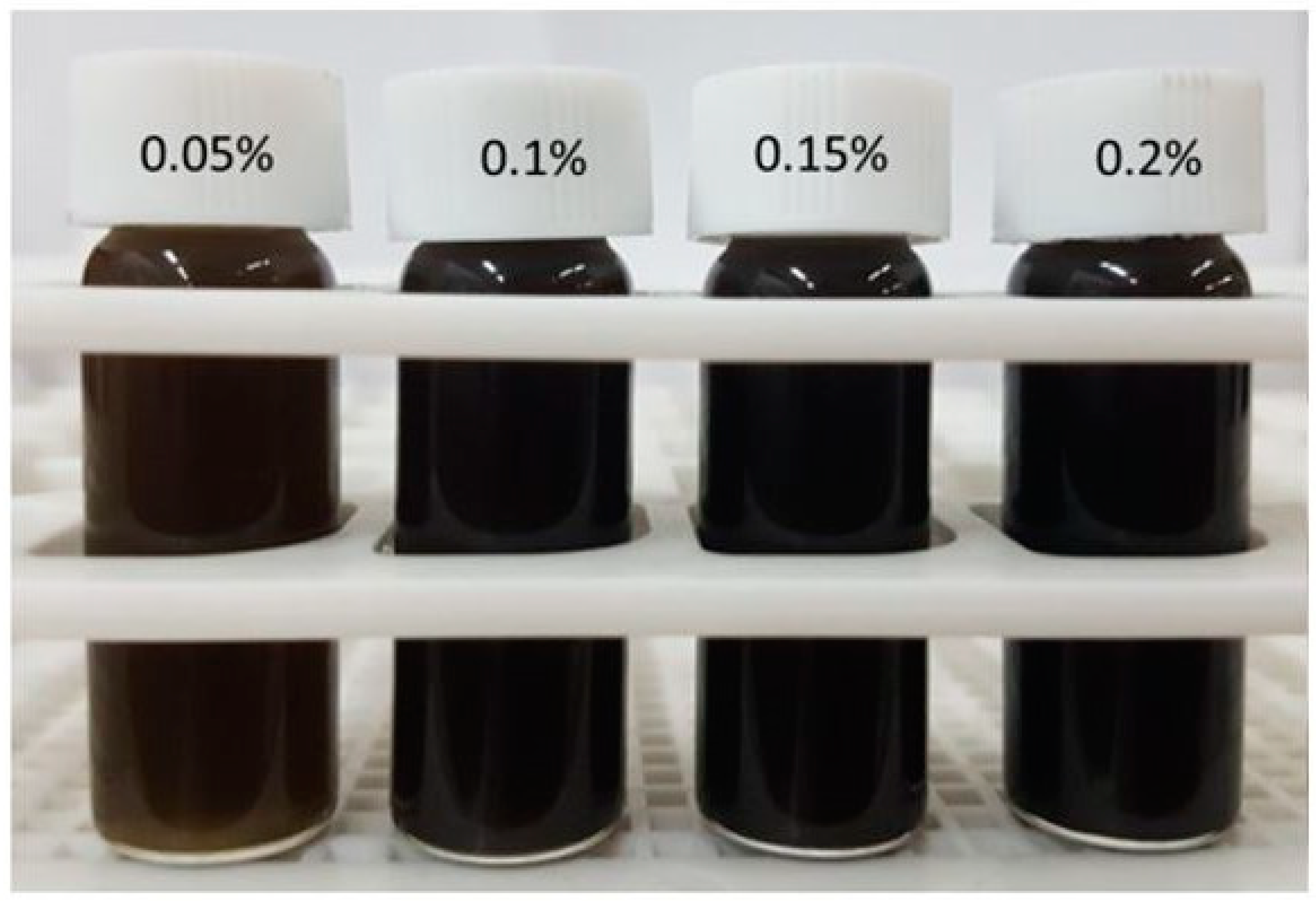
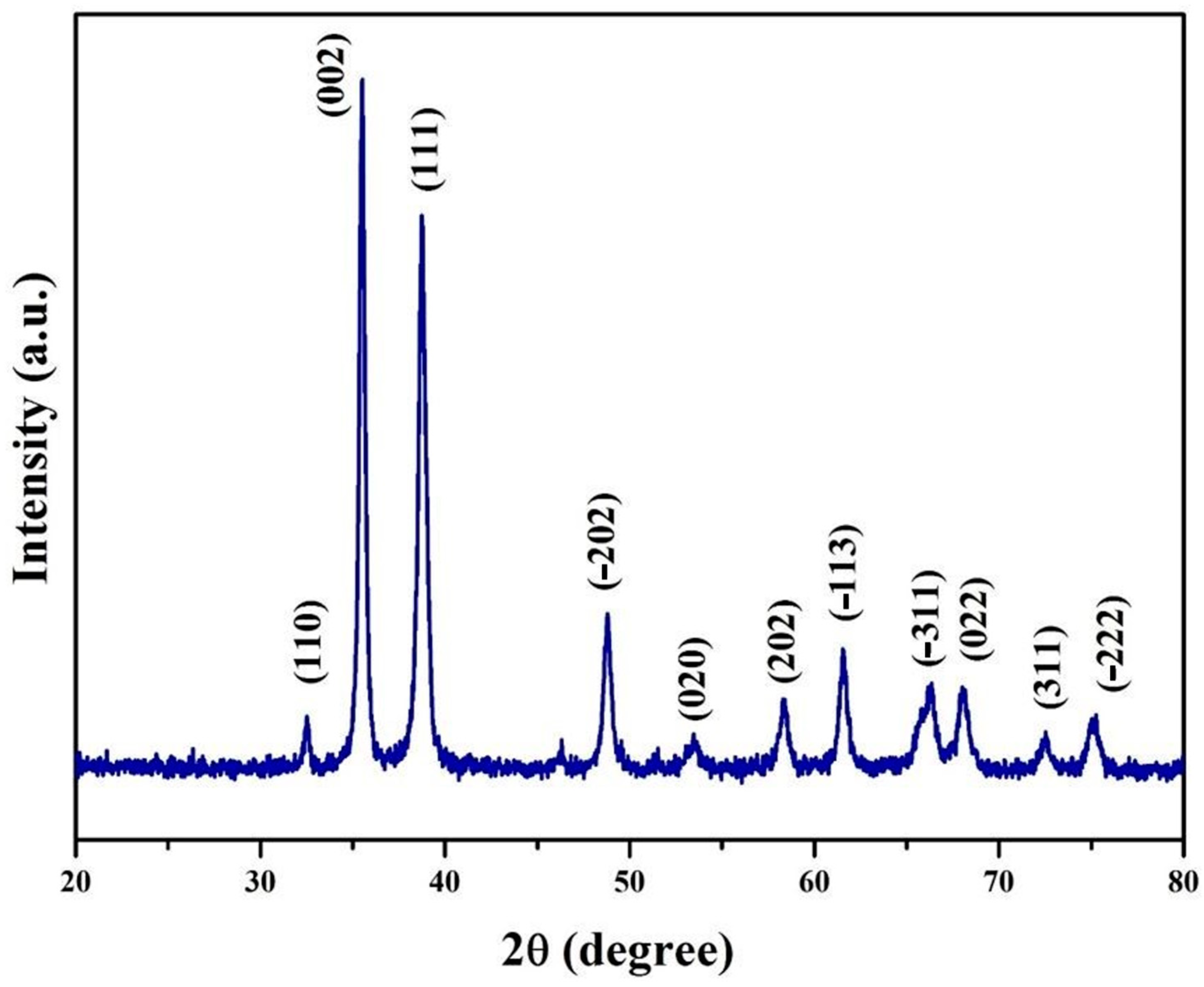
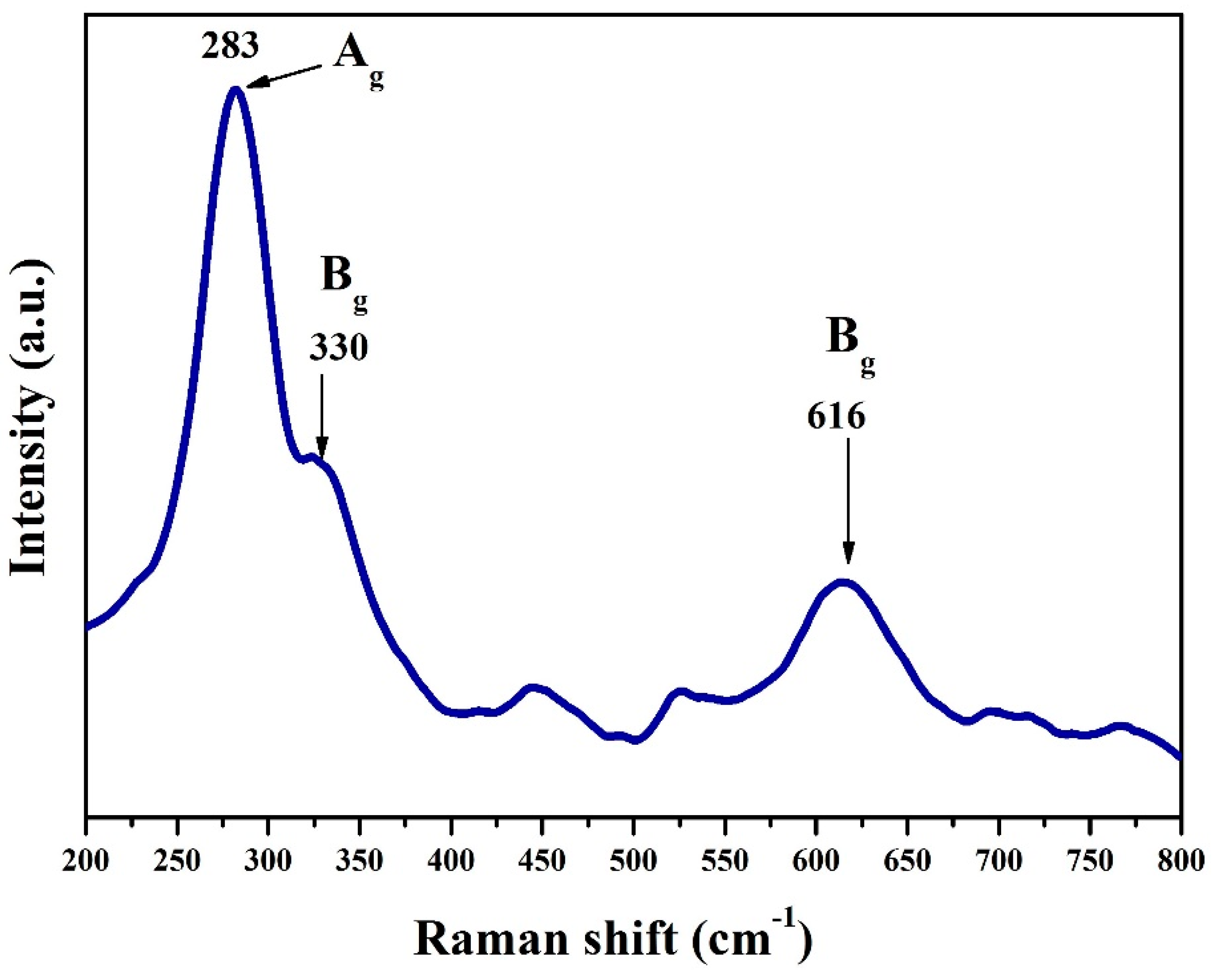

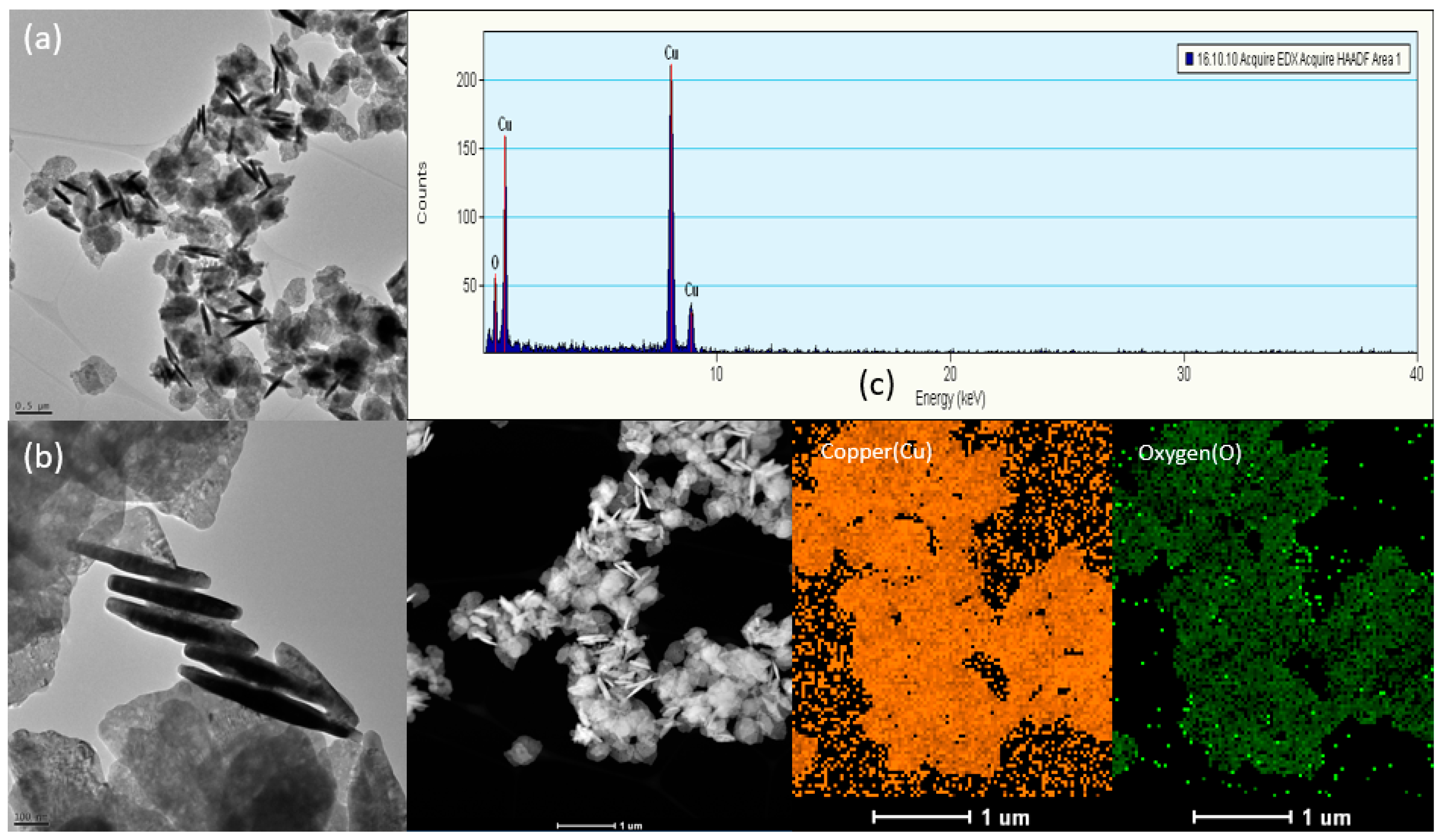
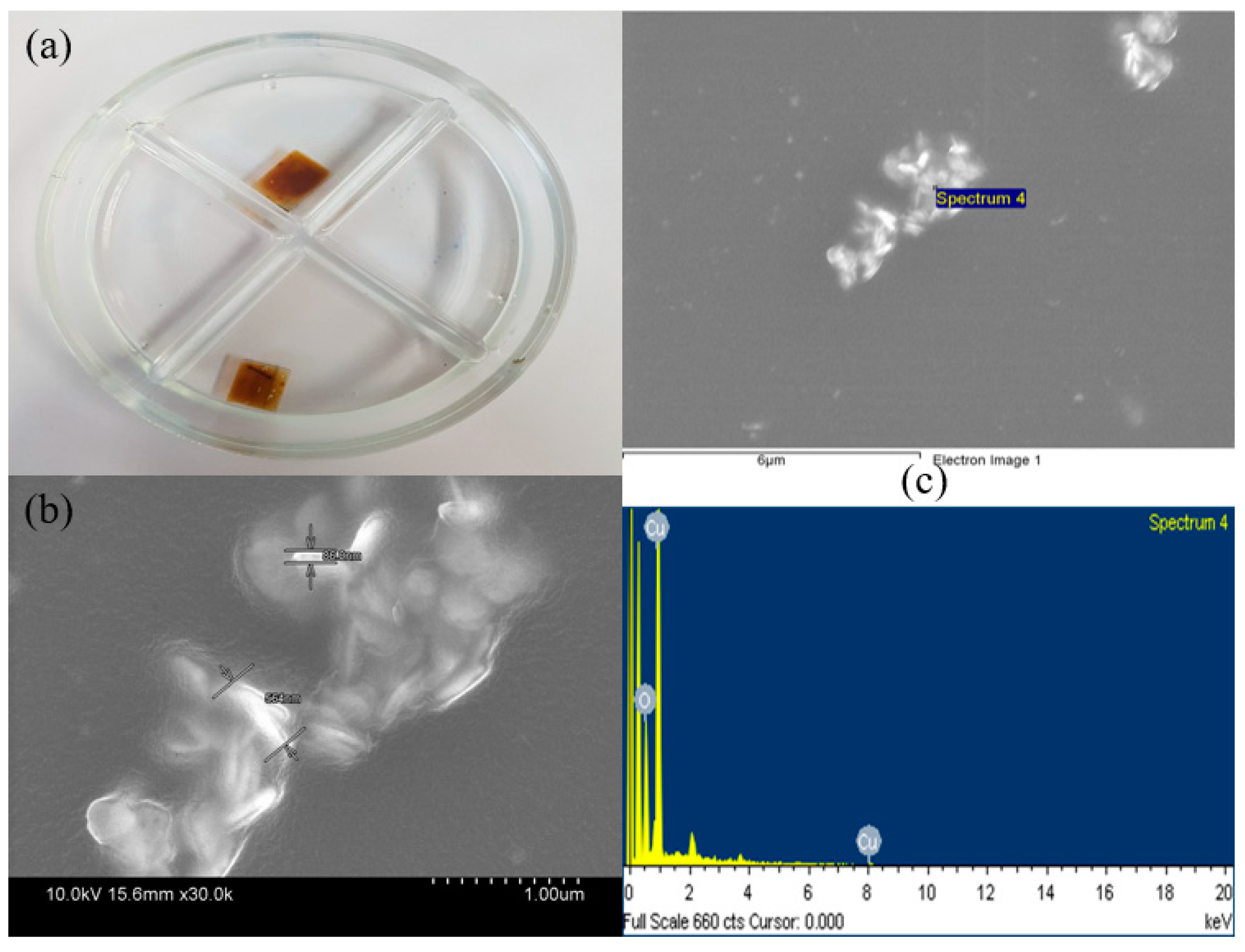
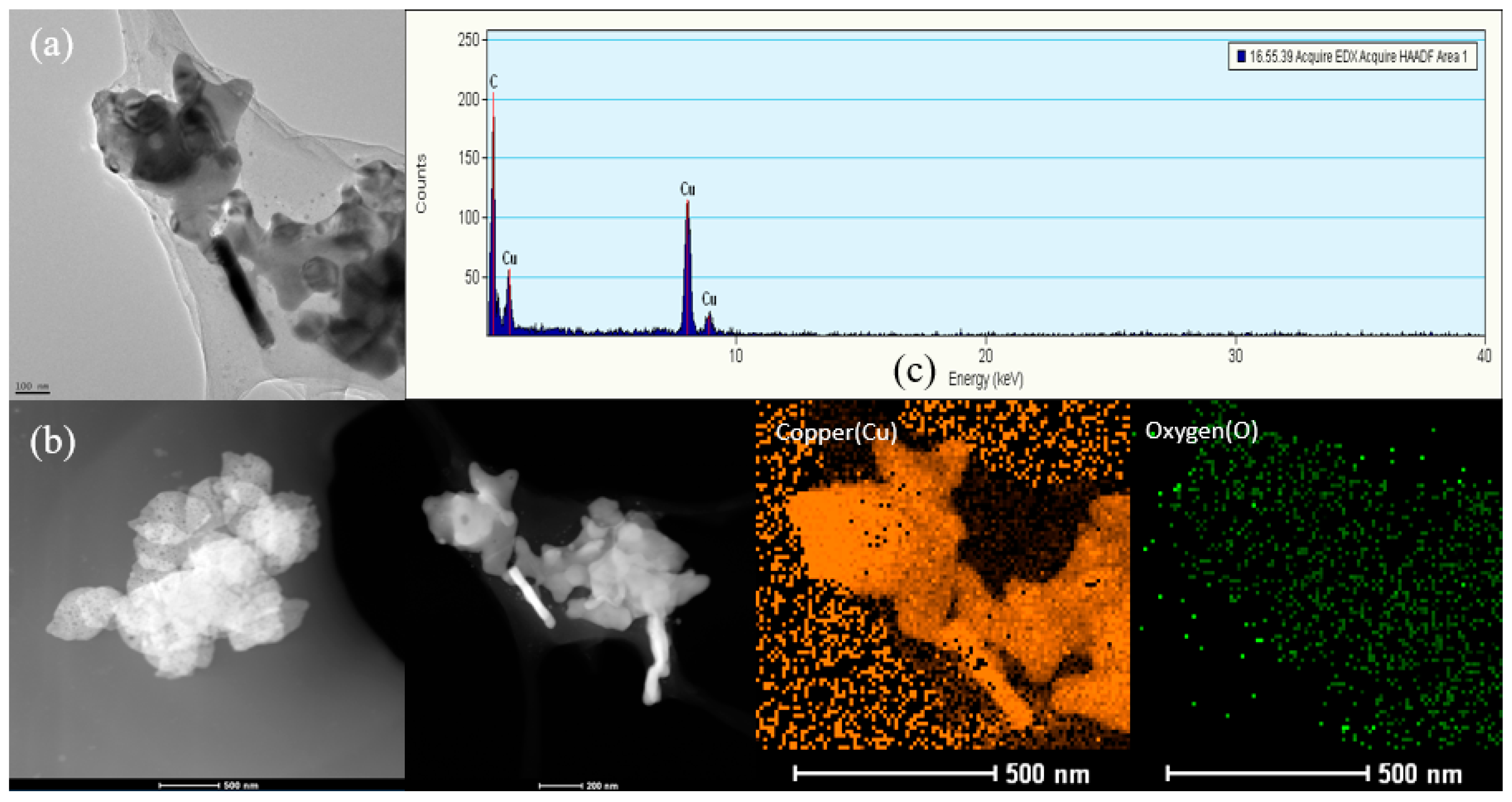

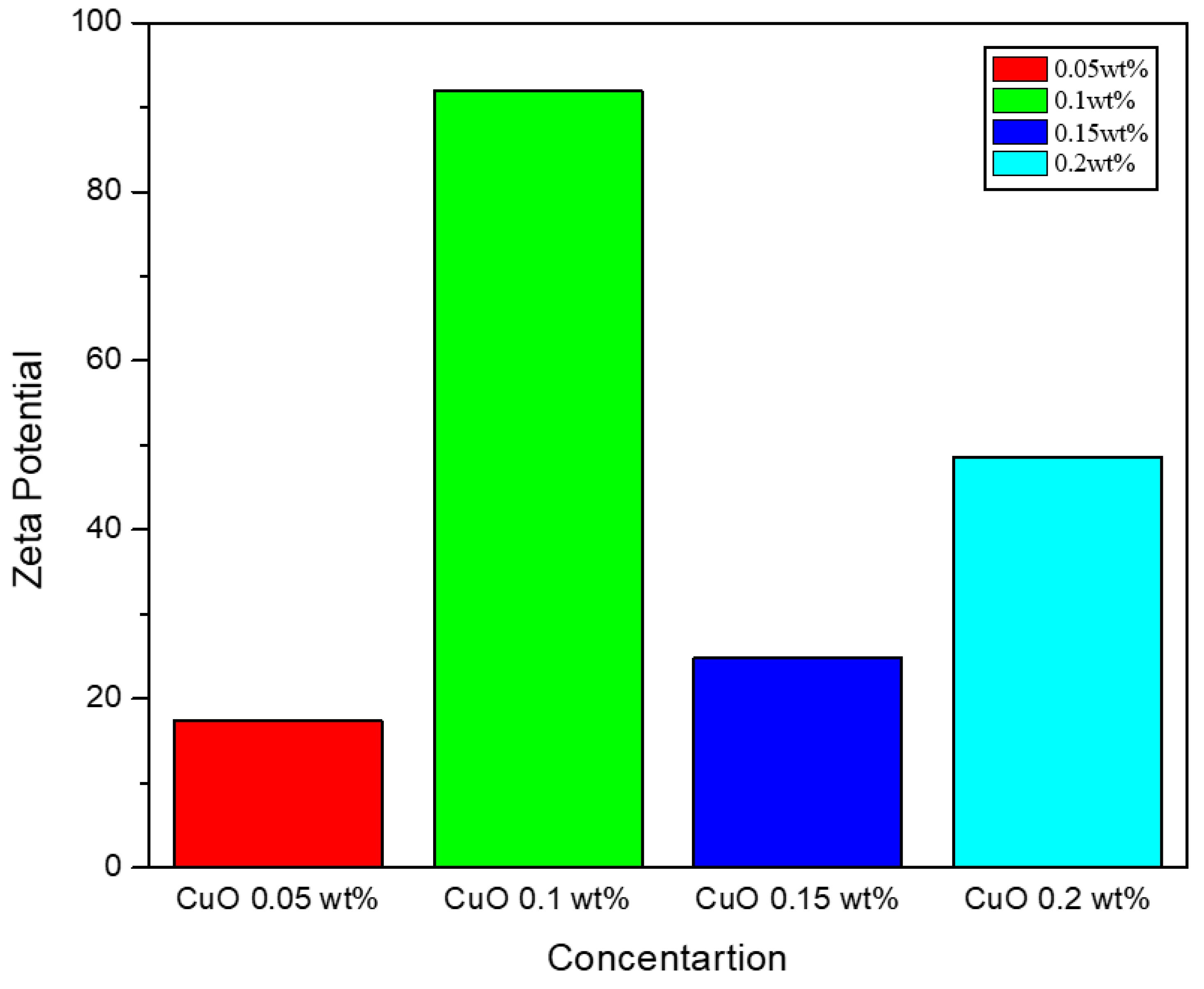

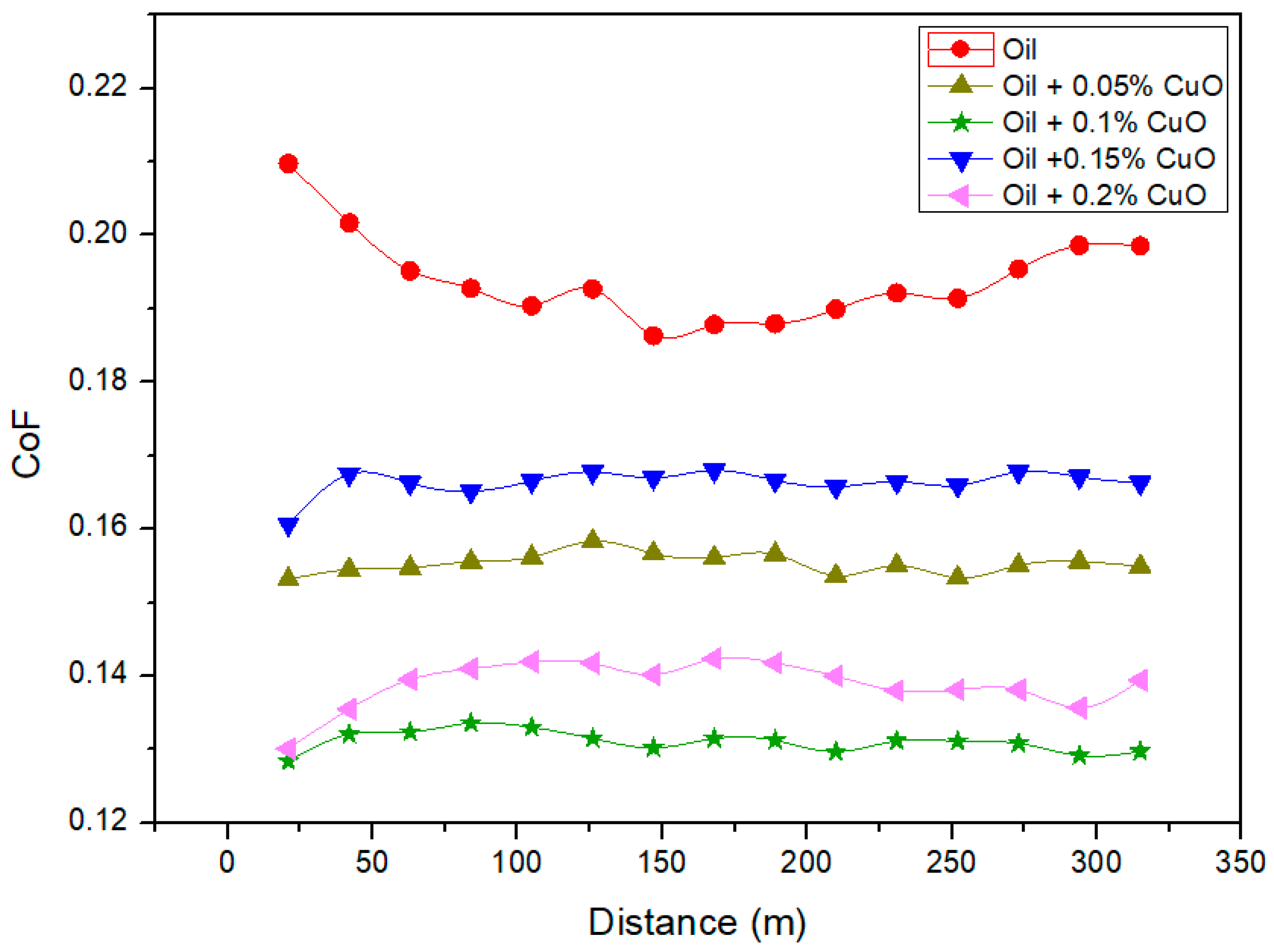
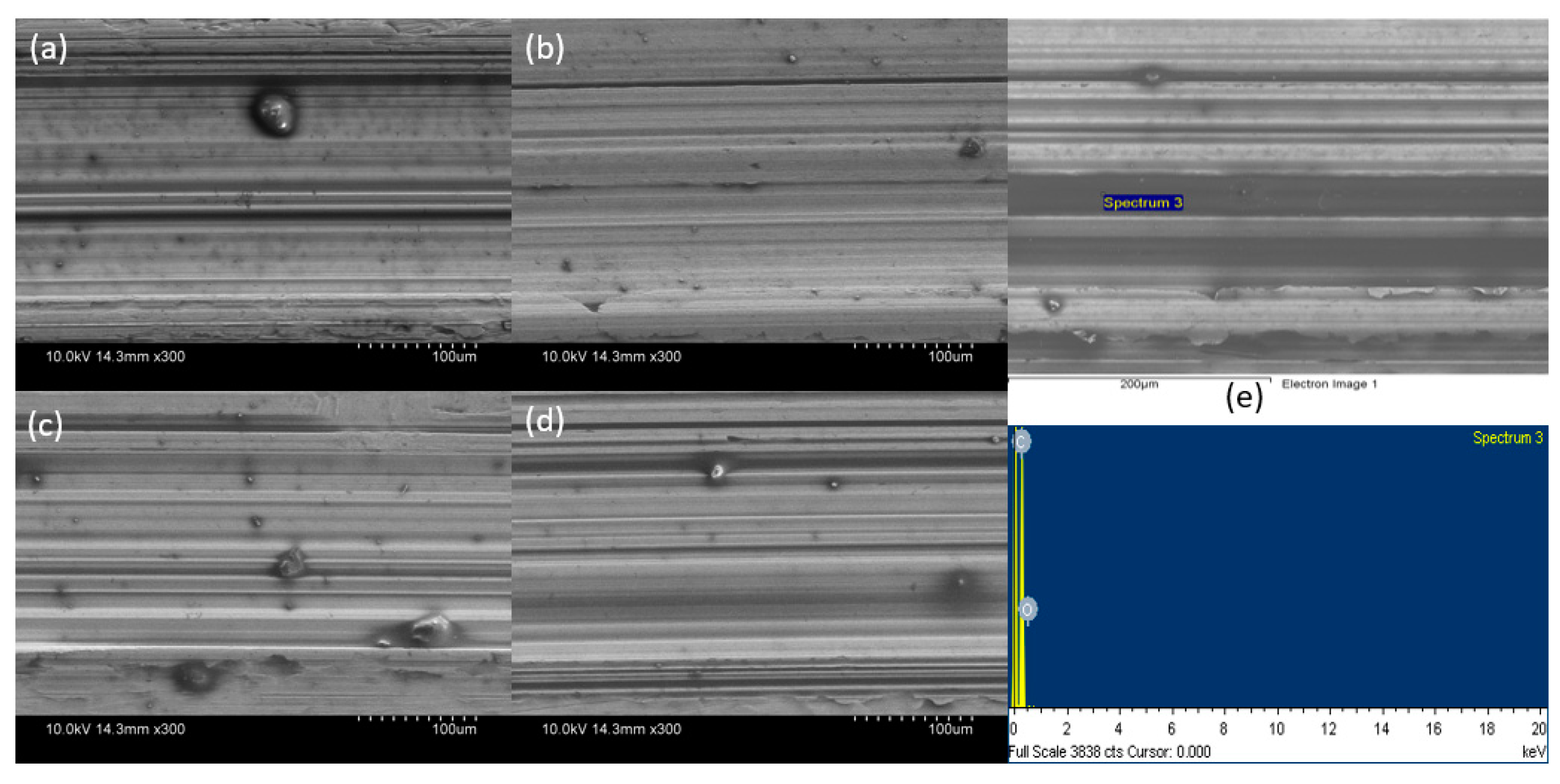

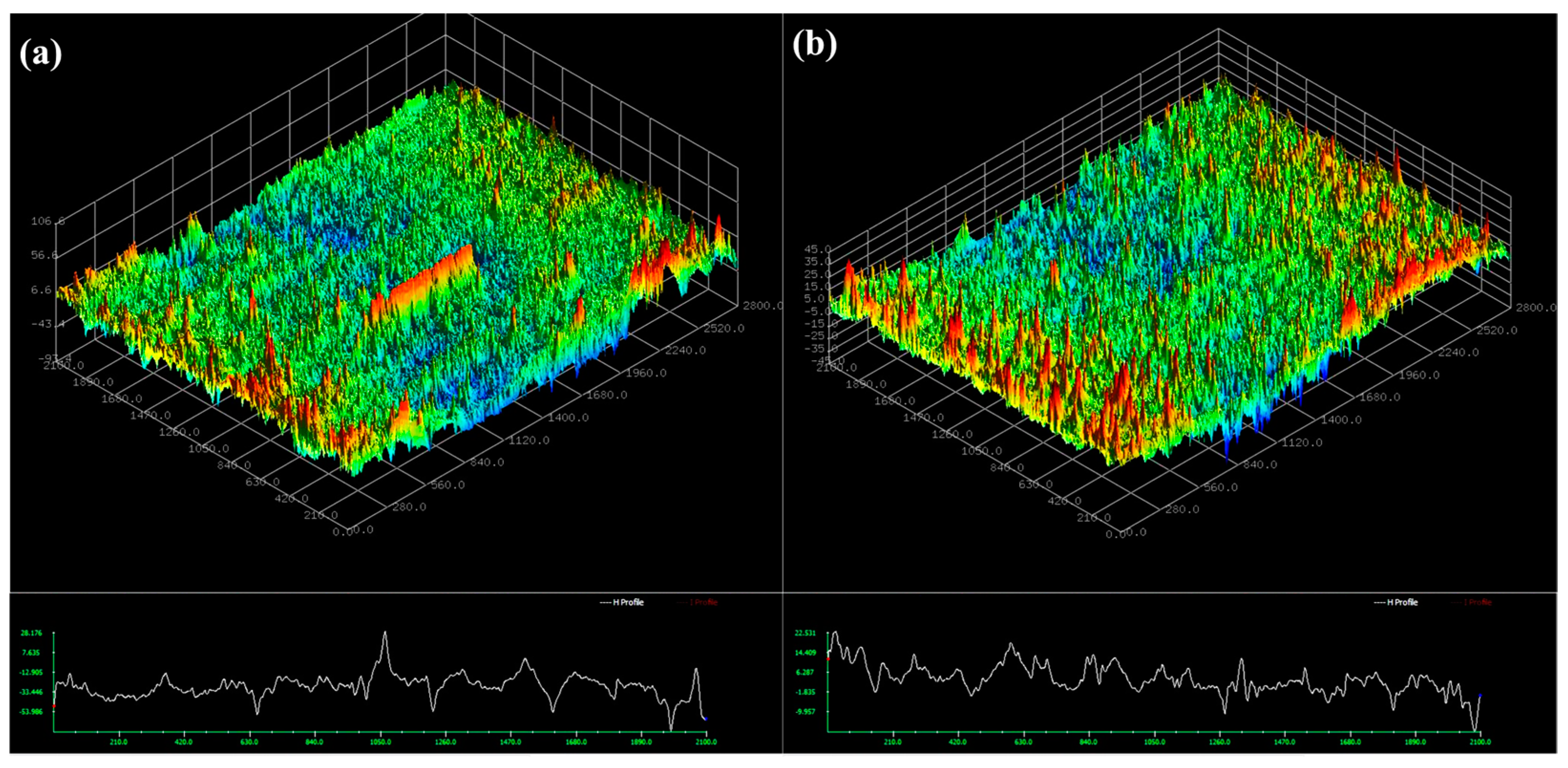
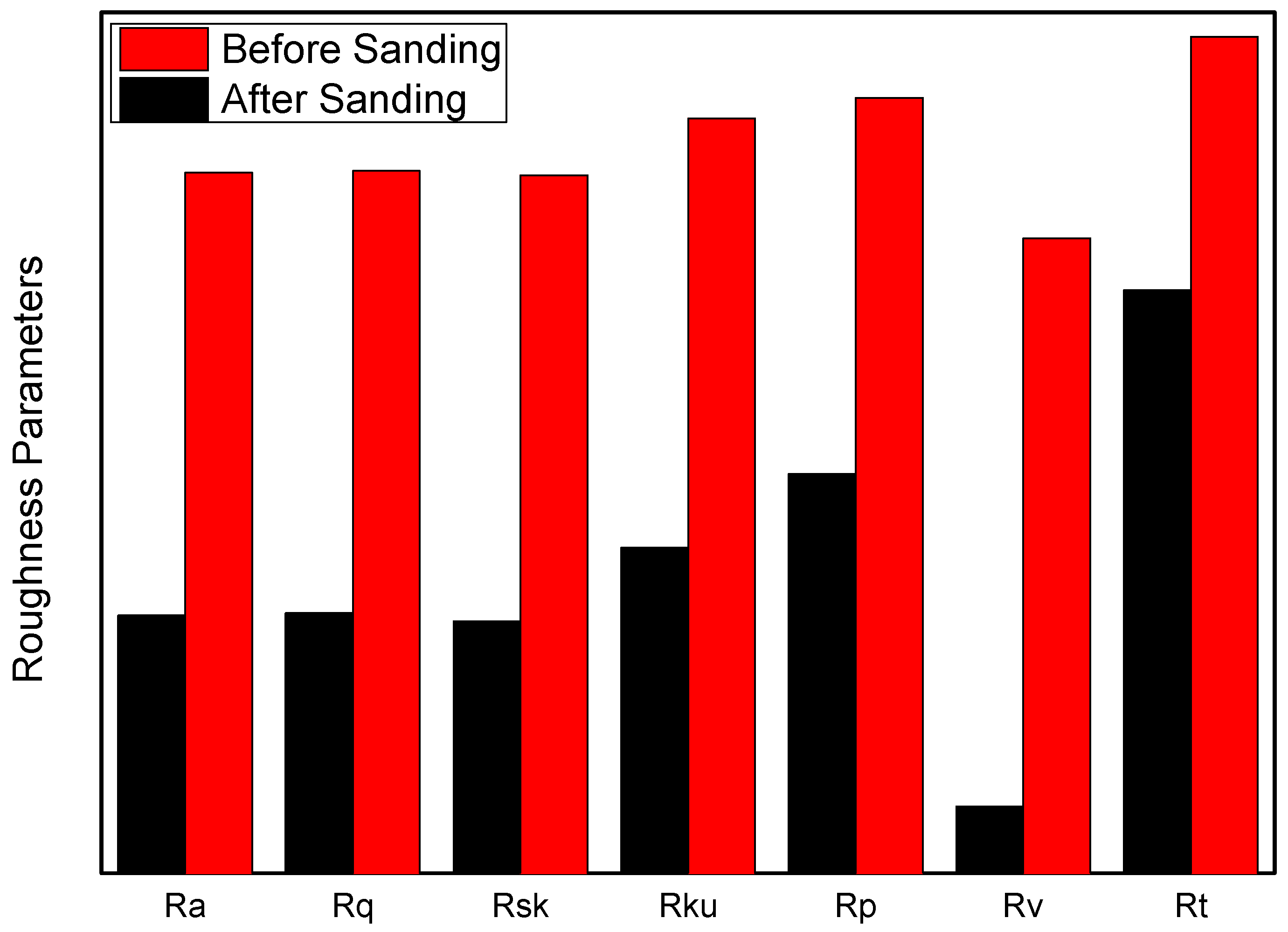
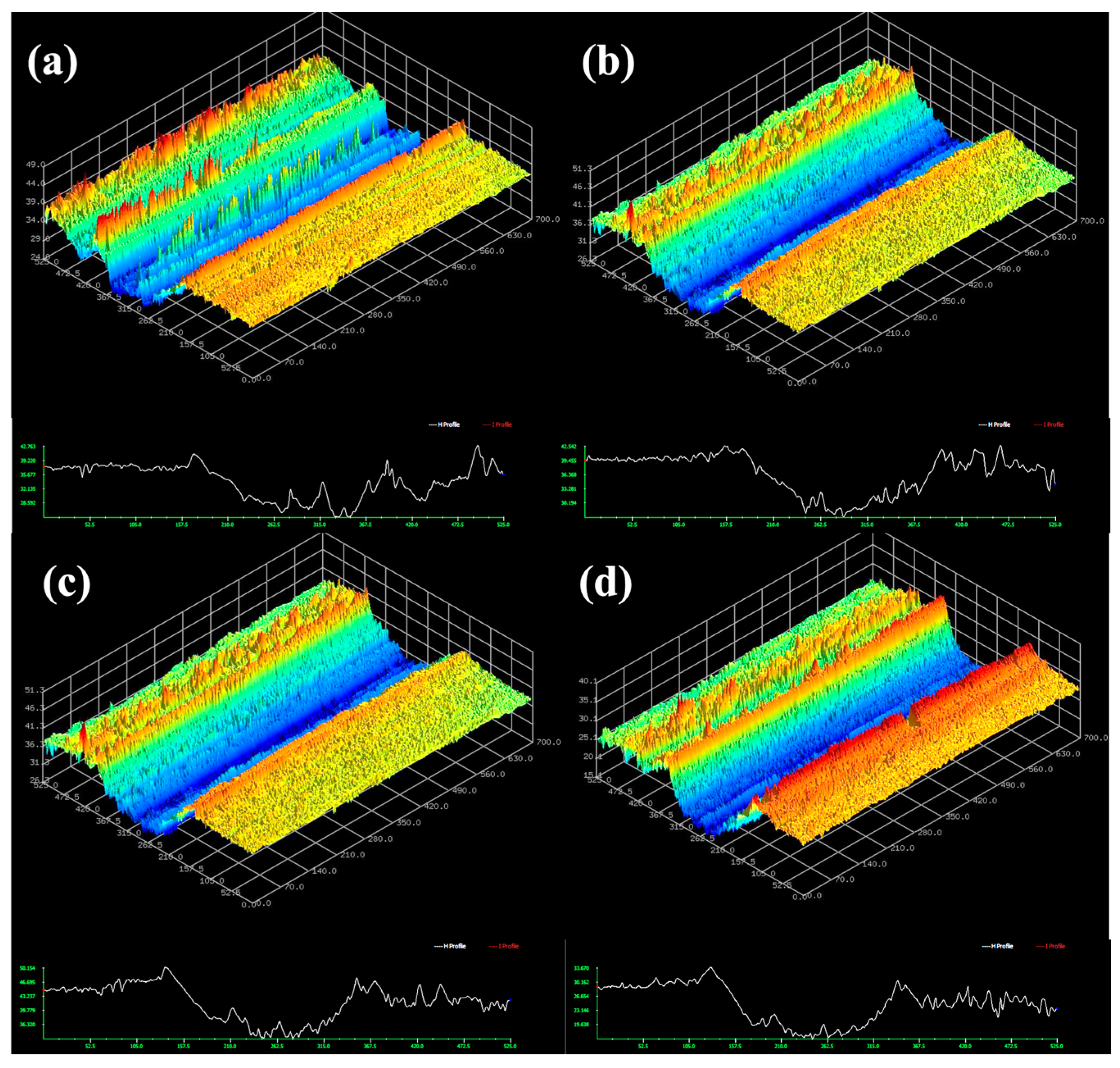

| Properties | Methods | Shell Helix Ultra 5W-40 |
|---|---|---|
| Viscosity Grade | data | 5W-40 |
| Kinematic Viscosity @40 °C (cSt) | ASTM D445 | 74.4 |
| Kinematic Viscosity @100 °C (cSt) | ASTM D445 | 13.1 |
| Density @15 °C (kg/L) | ASTN 4052 | 0.840 |
| Pour Point (°C) | ASTM D97 | −39 |
| Hths Viscosity @150 °C (m PaS) | ASTM D4741 | 3.68 |
| Flash Point (Pmcc) (°C) | ASTM D93 | 215 |
| Parameters | Value |
|---|---|
| Applied Load | 20 N |
| Speed of motor | 380 rpm |
| Sliding Speed | 1.4 m/min |
| Test Run Time | 4 h |
Disclaimer/Publisher’s Note: The statements, opinions and data contained in all publications are solely those of the individual author(s) and contributor(s) and not of MDPI and/or the editor(s). MDPI and/or the editor(s) disclaim responsibility for any injury to people or property resulting from any ideas, methods, instructions or products referred to in the content. |
© 2023 by the authors. Licensee MDPI, Basel, Switzerland. This article is an open access article distributed under the terms and conditions of the Creative Commons Attribution (CC BY) license (https://creativecommons.org/licenses/by/4.0/).
Share and Cite
Azam, S.; Park, S.-S. Sonochemical Synthesis of CuO Nanoplatelets and Their Tribological Properties as an Additive in Synthetic Oil Using Reciprocating Tribometer. Lubricants 2023, 11, 185. https://doi.org/10.3390/lubricants11040185
Azam S, Park S-S. Sonochemical Synthesis of CuO Nanoplatelets and Their Tribological Properties as an Additive in Synthetic Oil Using Reciprocating Tribometer. Lubricants. 2023; 11(4):185. https://doi.org/10.3390/lubricants11040185
Chicago/Turabian StyleAzam, Siraj, and Sang-Shin Park. 2023. "Sonochemical Synthesis of CuO Nanoplatelets and Their Tribological Properties as an Additive in Synthetic Oil Using Reciprocating Tribometer" Lubricants 11, no. 4: 185. https://doi.org/10.3390/lubricants11040185
APA StyleAzam, S., & Park, S.-S. (2023). Sonochemical Synthesis of CuO Nanoplatelets and Their Tribological Properties as an Additive in Synthetic Oil Using Reciprocating Tribometer. Lubricants, 11(4), 185. https://doi.org/10.3390/lubricants11040185






